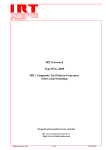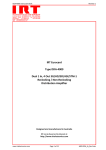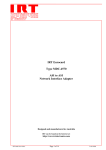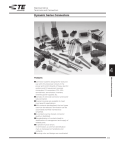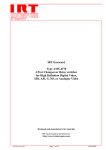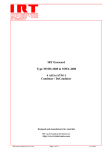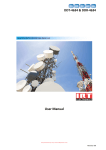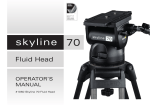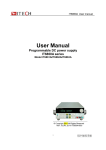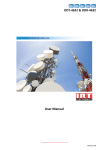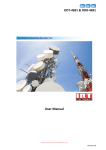Download User Manual - IRT Communications
Transcript
DAX-4200 Instruction Book Revision 1 I R T Electronics Pty Ltd A.B.N. 35 000 832 575 26 Hotham Parade, ARTARMON N.S.W. 2064 AUSTRALIA National: Phone: (02) 9439 3744 Fax: (02) 9439 7439 International: +61 2 9439 3744 +61 2 9439 7439 Email: [email protected] Web: www.irtelectronics.com IRT Eurocard Type DAX-4200 3G/HD/SD-SDI Digital Audio Extractor Designed and manufactured in Australia IRT can be found on the Internet at: http://www.irtelectronics.com www.irtelectronics.com Page 1 of 20 4200-DAX_ib_Rev1.doc DAX-4200 Instruction Book Revision 1 IRT Eurocard Type DAX-4200 3G/HD/SD-SDI Digital Audio Extractor Revision History Revision 0 1 Date 28/10/2009 02/05/2011 www.irtelectronics.com By AL AL Change Description Original Issue. Correction to Equalisation specification. Page 2 of 20 Applicable to: S/N: ≥ 0910001 S/N: ≥ 0910001 4200-DAX_ib_Rev1.doc DAX-4200 Instruction Book Revision 1 IRT Eurocard Type DAX-4200 3G/HD/SD-SDI Digital Audio Extractor Instruction Book Table of Contents Section Page Revision History Operational Safety General Description Technical Specifications Configuration DIP Switch Settings Video Generator Link Settings Location of DIP Switch and Links Installation Front and rear layouts Operation Top Layer Menu Structure STATUS Menu Structure Video Status Embedded Audio Status AES Reference Status Enter To Go Back CONFIG Menu Structure AES Group configuration Enter To Go Back Video Generator SNMP – What Is It? DAX-4200 SNMP Functions Maintenance & Storage Warranty & Service Equipment return 2 3 4 5 6 6 6 6 7 8 9 10 10 11 12 12 13 13 14 15 15 16 17 19 20 20 20 This instruction book applies to units later than S/N: 0910001. Operational Safety: WARNING Operation of electronic equipment involves the use of voltages and currents that may be dangerous to human life. Note that under certain conditions dangerous potentials may exist in some circuits when power controls are in the OFF position. Maintenance personnel should observe all safety regulations. Do not make any adjustments inside equipment with power ON unless proper precautions are observed. All internal adjustments should only be made by suitably qualified personnel. All operational adjustments are available externally without the need for removing covers or use of extender cards. www.irtelectronics.com Page 3 of 20 4200-DAX_ib_Rev1.doc DAX-4200 Instruction Book Revision 1 IRT Eurocard Type DAX-4200 3G/HD/SD-SDI Digital Audio Extractor General Description The DAX-4200 is a high performance embedded audio extractor for either 270 Mb/s SD-SDI, 1.485 Gb/s HD-SDI or 2.97 Gb/s 3G-SDI video signals. It is primarily designed to operate with IRT's DAI-4200 digital audio inserter but will work on any embedded SDI source. A typical SDI signal may contain up to eight audio pairs arranged in four groups. Each DAX-4200 is capable of extracting two audio groups (AES 1&2, and AES 3&4) from those available. Selection is made via a front panel local control switch, or via SNMP. * The DAX-4200 supports AES synchronous and asynchronous audio at 48 kHz, 24-bit audio data packets. A group presence indicator is provided for each group containing audio data. If no audio is detected in the selected group the corresponding outputs are muted. Simple Network Management Protocol (SNMP) monitoring and control is possible when mounted in an IRT frame fitted with SNMP capability. The DAX-4200 is fabricated in IRT's standard Eurocard format and may be housed in a variety of IRT Eurocard frames alongside other standard modules. Standard features: • • • • • • • • * 270 Mb/s SD-SDI, 1.485 Gb/s HD-SDI or 2.97 Gb/s 3G-SDI input and output Extracts up to 4 AES signals from 2 groups Indicators for presence of input (SDI) & audio within group (GRP) Four 75 Ω unbalanced AES outputs External AES reference input Cascadable - SDI output for connection to additional units Front panel Status and Configuration controls Simple Network Management Protocol (SNMP) capable Asynchronous mode possible for HD-SDI & 3G-SDI only. www.irtelectronics.com Page 4 of 20 4200-DAX_ib_Rev1.doc DAX-4200 Instruction Book Revision 1 Technical Specifications IRT Eurocard module Type DAX-4200 SDI input: Number Impedance Equalisation 1 (BNC). 75 Ω terminated. Automatic, >100 metres at 1.485 Gb/s & 2.97 Gb/s, >250 m at 270 Mb/s for Belden 8281 or equivalent cable. 270 Mbit/s (SD-SDI) video with or without embedded audio serial data to SMPTE 259M; or 1.485 Gbit/s (HD-SDI) video with or without embedded audio serial data to SMPTE 292M; or 2.97 Gb/s (3G-SDI) video with or without embedded audio serial data to SMPTE 424M. Format Reference AES input: Number Impedance Signal amplitude 1. 75 Ω unbalanced. 1 Vp-p ± 20%. SDI output: Number Type Format 1 (BNC). 75 Ω sourced. Regenerated and re-clocked, as per input type. AES outputs: Number Impedance Signal amplitude Audio pair 1 Audio pair 2 4 (2 groups). 75 Ω unbalanced. 1 Vp-p ± 20%. AES 1 & AES 2. AES 3 & AES 4. Front Panel Indicators: INPUT GRP1 GRP2 GRP3 GRP4 Control Switch Indicator Blue Control Switch Indicator Green Control Switch Indicator Orange SDI input present (Green). Audio present in Group 1 position (Green). Audio present in Group 2 position (Green). Audio present in Group 3 position (Green). Audio present in Group 4 position (Green). SDI input type – 3G. SDI input type – HD. SDI input type – SD. Front Panel Controls: Group select AES 1 & AES 2, or AES 3 & AES 4. Other: Power requirements 28 Vac CT (14-0-14) or ± 16 Vdc. Power consumption <6 VA. Temperature range 0 - 50° C ambient. Mechanical Suitable for mounting in IRT 19" rack chassis with input output and power connections on the rear panel. Finish: Front panel Rear assembly Grey background, black lettering & red IRT logo. Detachable silk-screened PCB with direct mount connectors to Eurocard and external signals. Dimensions 30 mm x 3 U x 220 mm IRT Eurocard. Accessories supplied with module Rear connector assembly. Related Modules DAI-4200 digital audio inserter. Due to our policy of continuing development, these specifications are subject to change without notice. www.irtelectronics.com Page 5 of 20 4200-DAX_ib_Rev1.doc DAX-4200 Instruction Book Revision 1 Configuration DIP Switch Settings: SW1-1 OFF Default DAX-4200 setting. Do not change. SW1-2 Not used (normal position OFF - default). SW1-3 OFF ON OFF ON SW1-4 OFF OFF ON ON Operation Video Generator on loss of SDI input disabled. SD Video Generator on loss of SDI input enabled. HD Video Generator on loss of SDI input enabled. 3G Video Generator on loss of SDI input enabled. SW1-5 OFF ON Colour Bars when Video Generator enabled via SW1-3 and SW1-4 settings. Colour Black when Video Generator enabled via SW1-3 and SW1-4 settings. SW1-6 Not used (normal position OFF - default). SW1-7 Not used (normal position OFF - default). SW1-8 OFF ON No audio resampling of AES outputs (normal position - default). Audio resampling of AES outputs to match AES Reference input enabled. When a valid AES audio is inputted to the AES Reference input, and SW1-8 is set to ON, the AES outputs are resampled to match the frequency of this AES reference signal. Note that unless SW1-8 is ON the status of the AES Reference input is not recognized. Video Generator: To allow an output SDI video signal on loss of SDI input, SW1-3 and SW1-4 enable an SD-SDI, HD-SDI or 3G-SDI signal, either colour bars or colour black as per the SW1-5 setting. When setting, set to expected SDI input type (SD, HD or 3G) so that signal types match, else downstream equipment may not function correctly. The colour bars give a visual indication of loss of SDI input. The colour black may be preferential for live broadcast applications. It is also possible to disable the video generator via the SW1-3 and SW1-4 settings for situations where a redundant backup system automatically switches in independent of this card. Link Settings: LK1 B Factory use only. Default position. Do not change. LK2 A Factory use only. Default position. Do not change. LK3 OPEN Factory use only. Default position. Do not change. www.irtelectronics.com Page 6 of 20 4200-DAX_ib_Rev1.doc DAX-4200 Instruction Book Revision 1 Location of DIP Switch and Links: IC26 www.irtelectronics.com 6 7 8 LK2 LK1 Page 7 of 20 1 SW1 1 2 + C213 ON + C217 B 3 4 5 DIP A LK3 4200-DAX_ib_Rev1.doc DAX-4200 Instruction Book Revision 1 Installation Pre-installation: Handling: This equipment may contain or be connected to static sensitive devices and proper static free handling precautions should be observed. Where individual circuit cards are stored, they should be placed in antistatic bags. Proper antistatic procedures should be followed when inserting or removing cards from these bags. Power: AC mains supply: Ensure that operating voltage of unit and local supply voltage match and that correct rating fuse is installed for local supply. DC supply: Ensure that the correct polarity is observed and that DC supply voltage is maintained within the operating range specified. Earthing: The earth path is dependent on the type of frame selected. In every case particular care should be taken to ensure that the frame is connected to earth for safety reasons. See frame manual for details. Signal earth: For safety reasons a connection is made between signal earth and chassis earth. No attempt should be made to break this connection. Installation in frame or chassis: See details in separate manual for selected frame type. Connections: SDI Video: Input: The SDI input is a single BNC connector terminated in 75 Ohms. The input equaliser compensates automatically for losses of up to 250 metres for SD-SDI, and up to 100 metres of HD-SDI or 3G-SDI, of high quality 75 Ohm coaxial cable. Performance tests are made using Belden 8281 cable as a reference. Actual results and bit error rates will depend on the quality of the cable and the noise environment as well as the quality of the originating equipment. Output: One 75 Ohm impedance SDI output is provided matching the input type with the relevant embedded AES data. This output should only be used with 75 Ohm coaxial cable and must be 75 Ohm terminated at the destination in order to obtain correct levels and performance. When more than two groups need to be embedded with AES data, this output cascades into the input of a second DAI-4200 inserter card to allow all four groups of an SDI stream to be embedded. AES Data: Outputs: The four AES data outputs, typically AES audio, are single BNC connectors terminated in 75 Ohms. AES 1&2 form one audio/data grouping, AES 3&4 form the second audio/data grouping. Each audio/data grouping can be extracted from a different one of the four possible audio/data group numbers within an SDI stream. It is not possible to extract both audio/data groupings from the same SDI group number. AES Reference Input: The AES Reference input is a single BNC connector terminated in 75 Ohms. When a valid AES signal is present at the input, and switch SW1 is ON, the output AES’s are resampled to match the frequency of this AES input. www.irtelectronics.com Page 8 of 20 4200-DAX_ib_Rev1.doc DAX-4200 Instruction Book Revision 1 Front & rear panel connector diagrams The following front panel and rear assembly drawings are not to scale and are intended to show connection order and approximate layout only. DAX- 42 00 PL1 SDI IN SK7 INPUT GRP1 GRP2 GRP3 GRP4 SDI OUT SK6 PRESS TO ENTER OUT1 AES OUT2 SK2 OUT3 SK3 UP OUT4 SK4 DOWN SK5 DC SWITCH BACKGROUND BLUE - 3G GREEN - HD ORANGE - SD AES IN1 PL2 SK8 N140 www.irtelectronics.com Page 9 of 20 4200-DAX_ib_Rev1.doc DAX-4200 Instruction Book Revision 1 Operation The DAX-4200 will extract up to two groupings of AES audio or data (AES 1&2 and AES 3&4) from within two separate SDI group numbers. To extract from all four possible group numbers within an SDI stream two DAX-4200s can be cascaded together. The SDI input stream can be either 3G-SDI (2.97 Gb/s), HD-SDI (1.485 Gb/s) or SD-SDI (270 Mb/s). The output stream matches that of the input stream. The front panel comprises of an INPUT and four group (GRP) green LED indicators, and three pushbutton switches a large square pushbutton switch in the middle of the panel acting as the MENU SCREEN, and two smaller square pushbuttons below marked with UP and DOWN arrows. The INPUT LED illuminates when an SDI input signal is connected to the SDI IN connector on the rear assembly. If any of the four groups within the SDI stream contain audio or data the corresponding front panel GRP number LED will illuminate. The MENU SCREEN pushbutton will illuminate to indicate the type of SDI input signal detected – a blue background for a 3G-SDI signal; a green background for an HD-SDI signal; and an orange background for an SD-SDI signal. STATUS of the input SDI signal and CONFIGURATION settings for the AES extraction are performed via the MENU SCREEN pushbutton in conjunction with the two smaller UP/DOWN pushbuttons. Top Layer Menu Structure: . There are three top layer menus on the MENU SCREEN pushbutton. The top default screen has the display Scrolling down the menus by pressing the DOWN arrow pushbutton comes the STATUS menu followed by the CONFIG menu, then back to the menu again. All the following examples have the background colour corresponding to an SD-SDI input signal. Enter for STATUS Enter for CONFIG To enter the STATUS or CONFIG menus, push the MENU SCREEN pushbutton when at the corresponding menu screen to open the next sub-menu. Pressing the menu does not do anything as there are no sub-menus below this screen. After a period of time, if left in one of the other menu screens, the menu defaults back to the screen. www.irtelectronics.com Page 10 of 20 4200-DAX_ib_Rev1.doc DAX-4200 Instruction Book Revision 1 STATUS Menu Structure: Pressing the STATUS menu option gives status information about the inputted signals such as the type of SDI signal present (3G, HD or SD), whether the four Groups of the SDI signal contain AES data or not, and whether the AES reference input is present or not. It does not give status information about the configuration settings. The CONFIG menu gives this information when setting. The following menu structure shows the various status information screens. To scroll between the various submenus under the STATUS menu press the UP / DOWN arrow pushbuttons on the front panel. Enter for STATUS Enter for CONFIG Video Stat SDI INPUT SD-SDI Enter for EMBEDDED AUDIO AES REF Audio Stat Group 1 Present Present Audio Stat Group 2 Present ENTER TO GO BACK Audio Stat Group 3 Missing Audio Stat Group 4 Missing www.irtelectronics.com Page 11 of 20 4200-DAX_ib_Rev1.doc DAX-4200 Instruction Book Revision 1 1. Video Status: The first menu under the STATUS menu is the Video Status screen. Video Stat SDI INPUT SD-SDI This screen shows what type of input signal is present: 3G-SDI; HD-SDI; SD-SDI; or Unlocked - for no input or invalid inputs (non SDI). Pressing this switch when in this position switches back to the previous “Enter for STATUS” menu screen. 2. Embedded Audio Status: The second menu under the STATUS menu is the EMBEDDED AUDIO status. Pressing this switch when in this position switches to a sub-menu of Audio Status, which indicate the presence (Present) or absence (Missing) of AES data within the four individual audio groups of the SDI input stream. The four audio groups are designated as Group 1, Group 2, Group 3, and Group 4. To access information about each individual group, scroll either UP or DOWN arrow pushbutton on the front panel until the desired group number is shown. In the example below Groups 1 & 2 both contains AES data (Present) whilst Groups 3 & 4 both do not contain any AES data (Missing). Pressing this switch when in any of these positions switches back to the previous “Enter for EMBEDDED AUDIO” menu screen. Enter for EMBEDDED AUDIO www.irtelectronics.com Page 12 of 20 Audio Stat Group 1 Present Present / Missing Audio Stat Group 2 Present Present / Missing Audio Stat Group 3 Missing Present / Missing Audio Stat Group 4 Missing Present / Missing 4200-DAX_ib_Rev1.doc DAX-4200 Instruction Book Revision 1 3. AES Reference Status: The third menu under the STATUS menu is the AES REFERENCE status. This menu indicates the presence (Present) or absence (Missing) of AES reference input signal on the rear assembly. AES REF Present Present / Missing When present, provided that switch SW1-8 has been set to the ON position, the extracted AES outputs are resampled to match the frequency of this AES reference signal. Note that unless switch SW1-8 is set to ON, the AES REF Status indicates Missing regardless of whether an actual reference signal is connected or not. 4. Enter To Go Back: The fourth menu under the STATUS menu is the ENTER TO GO BACK screen. ENTER TO GO BACK Pressing this switch when in this position switches back to the previous “Enter for STATUS” menu screen. www.irtelectronics.com Page 13 of 20 4200-DAX_ib_Rev1.doc DAX-4200 Instruction Book Revision 1 CONFIG Menu Structure: Pressing the CONFIG menu option gives configuration settings for embedding the input AES data. The following menu structure shows the various configuration settings. To scroll between the various sub-menus under the CONFIG menu press the UP / DOWN arrow pushbuttons on the front panel. Enter for STATUS Enter for CONFIG www.irtelectronics.com AES 1&2 Group 1 AES 3&4 Group 2 AES 1&2 extracted from either Group 1 / Group 2 / Group 3 / Group 4. AES 3&4 extracted from either Group 1 / Group 2 / Group 3 / Group 4. (Note: AES 1&2 cannot be same group number as AES 3&4). ENTER TO GO BACK Switches back to ‘Enter for CONFIG’ window. Page 14 of 20 4200-DAX_ib_Rev1.doc DAX-4200 Instruction Book Revision 1 1. AES Group configuration: The first menu under the CONFIG menu is the AES Group screen. AES 1&2 Group 1 AES 3&4 Group 2 AES 1&2 form one audio/data group, AES 3&4 form a second audio/data group. An SDI signal contains positions for four audio/data groups. Each audio/data group contains up to two AES streams. Pressing this switch when in this position allows the outputted AES 1&2 and AES 3&4 signals to be extracted from two of the four allowable Group numbers. Front panel LEDs and EMBEDDED AUDIO status menu gives an indication of which groups contain AES data available for extraction. When pressed, with an input SDI signal present, the background screen colour changes to red with a flashing asterisk (*) marker to the right of to the Group number corresponding to AES 1&2. Note that when no input SDI is signal present the background screen does not change to red, only the flashing asterisk marker is present. AES 1&2 Group 1 AES 3&4 Group 2 * To change the Group number of the AES 1&2 audio/data group between the four possible Group numbers, scroll either the UP or DOWN arrow pushbutton on the front panel to the desired setting and then press the menu button. The Group number setting for AES 1&2 is now set and the asterisk (*) marker then moves down to the next Group number of the AES 3&4 audio/data group. AES 1&2 Group 1 AES 3&4 Group 2 * It is possible to set the Group number for AES 1&2 to any of the possible four settings. If the selected Group number matches that of what AES 3&4 are set for, the Group number of AES 3&4 automatically changes to the next available number. For example, if AES 1&2 are set to Group 2, and AES 3&4 are already set to Group 2, AES 3&4 will automatically change to Group 3. Once the Group number for AES 1&2 has been set, AES 3&4 can only be set to one of the three remaining Group numbers. To change the Group number of the AES 3&4 audio/data group between the three remaining possible Group numbers, scroll either the UP or DOWN arrow pushbutton on the front panel to the desired setting and then press the menu button. The asterisk then disappears and the background colour goes back to match the SDI input type. 2. Enter To Go Back: The second menu under the CONFIG menu is the ENTER TO GO BACK screen. ENTER TO GO BACK Pressing this switch when in this position switches back to the previous “Enter for CONFIG” menu screen. www.irtelectronics.com Page 15 of 20 4200-DAX_ib_Rev1.doc DAX-4200 Instruction Book Revision 1 Video Generator: Colour Bars or Colour Black Video Generator on loss of SDI input allow an active path for AES insertion transmission. Once set there are no user operation controls. See Configuration section of this manual for DIP switch settings. When automatic changeover of signals is to take place on a loss of SDI signal, video generator should be disabled www.irtelectronics.com Page 16 of 20 4200-DAX_ib_Rev1.doc DAX-4200 Instruction Book Revision 1 SNMP What Is It? SNMP stands for Simple Network Management Protocol. It is an application layer protocol for managing IP (Internet Protocol) based systems. SNMP enables system administrators to manage system performance, and to find and solve system problems. SNMP runs over UDP (User Datagram Protocol), which in turn runs over IP. Three types of SNMP exist: SNMP version 1 (SNMPv1), SNMP version 2 (SNMPv2) and SNMP version 3 (SNMPv3). It is not the intention here to discuss the differences between various versions, only to bring attention to the fact that IRT Electronics modules, fitted with SNMP capability, use SNMPv1. An SNMP managed network consists of three key components: Network Management Systems (NMS), agents, and managed devices. An NMS is the console through which the network administrator performs network management functions, such as monitoring status (e.g. alarm states) and remote controlling, of a set of managed devices. One or more NMSs must exist on any managed network. Generally the NMS is a computer running third party SNMP control software. There are a number of third party SNMP software applications currently available on the market. An NMS polls, or communicates with, an agent. An agent is a network management software module that resides in a managed device. An agent has local knowledge of management information and translates that information into a form compatible with SNMP. The agent, therefore, acts as an interface between the NMS and the managed devices. The NMS sends a request message, and control commands for the managed devices, to the agent, which in turn sends a response message, containing information about the managed devices, back to the NMS. A managed device contains an SNMP agent and resides on a managed network. Managed devices collect and store management information and make this information available to NMSs using SNMP. Managed device agent variables are organised in a tree structure known as a Management Information Base (MIB). Within the MIB are parameters pertaining to the managed device. An Object Identifier (OID) number within the MIB defines the managed device type. This is a unique number specific to the model of managed device. Other information relating to the device is also stored, information such as alarm states, controllable settings, etc. The MIB tree is organised in such a way that there will be no two MIB files with conflicting placements. Normally an NMS polls an agent for information relating to the MIB in a managed device to be sent back to the NMS. When certain conditions are met within the MIB, such as major alarm conditions, for example, the agent automatically sends what is known as a trap to the NMS without any prompting from the NMS. This allows automatic notification of a predetermined event. SNMP Block Diagram SNMP Agent NMS MIB SNMP Agent MIB SNMP Agent MIB SNMP Agent Protocol Engine IP Network SNMP Agent Protocol Engine NMS SNMP Agent Protocol Engine www.irtelectronics.com Page 17 of 20 4200-DAX_ib_Rev1.doc DAX-4200 Instruction Book Revision 1 SNMP with IRT Products: IRT Electronics currently employs SNMPv1 with its SNMP capable frames. The frame acts as an agent when fitted with a CDM-xxxx module. This module has its own designated slot next to the power supply so as to not affect the number of modules that the frame will take. Communication between the NMS, the frame and its loaded modules are via this CDM-xxxx module. Note that the NMS software is third party and not supplied by IRT Electronics. Ethernet connection for SNMP operation is via an RJ45 connector on the rear of the frame, below the mains inlet. Ethernet rate runs at either 10 baseT or 100 baseT. Frame parameters, such as Name, Address and Location, are set via an RS232 interface, a D9 connector on the rear of the frame below the mains inlet. A software terminal emulator, such as Tera Term or HyperTerminal, is used for setting and reading the parameters of the frame. IRT modules that are SNMP compatible need a plug-in SMU-4000 module with a program relevant to the module that it is plugged into. Depending on the module, besides the module identification, parameters such as alarm states, inputs and controls etc. are communicated to the CDM-xxxx agent via a data bus on the rear of the frame. Thus the CDM-xxxx collects information on what is loaded within the frame, what positions they occupy, and their current status for communication to the NMS when the NMS sends a request for information. In the event of a major alarm from any of the SNMP compatible modules, or power supplies, a trap is automatically sent by the CDM-xxxx agent to the NMS without any prompting by the NMS. This alerts the operator to any fault conditions that may exist that need immediate attention. 110/240 V 50/60 Hz 0.7 A (max.) FRU-4000 FRAME FUSES 220/240 Vac 500 mA S.B. 110/120 Vac 1A S.B. RS232 Alarm Ethernet + 48Vdc AS3260 approval no.: CS6346N Ass. no.: 804692 IRT SNMP Connections IRT modules fitted with SMU-4000 NMS Ethernet Cable IP Network CDM-xxxx PSU’s IRT SNMP Frame Ethernet Cable IRT modules fitted with SMU-4000 CDM-xxxx PSU’s IRT SNMP Frame Ethernet Cable IRT SNMP Setup www.irtelectronics.com Page 18 of 20 4200-DAX_ib_Rev1.doc DAX-4200 Instruction Book Revision 1 DAX-4200 SNMP Functions: The DAX-4200 comes with SNMP capability built in as standard. When installed in an IRT frame with SNMP capability, the DAX-4200 can be interrogated by an SNMP Network Management System (NMS). The following SNMP functions are capable of being monitored and/or set by an NMS: An indication that an input SDI signal is present and its type (notPresent (1), sd (2), hd (3) or sdi3g (4)); An indication of the presence of each of the existing Group numbers within the inputted SDI (notPresent (1), present (2)); † An indication of the presence or absence of an AES reference signal (notPresent (1), present (2)); ‡ An indication and control of the Group numbers assigned to AES 1&2 and AES 3&4; An indication of the firmware version of the FPGA in the format x.y where x is the major revision number and y is the minor revision number; An indication of the software version of the FPGA in the format x.y where x is the major revision number and y is the minor revision number; Trap automatically sent, if enabled, on loss or insertion of SDI input (enabled (1), disabled (2)); and Unit reset control - resets system up time counter. A set with a value of 2 sent to this OID will cause a system reset to occur. When queried returns 1. NOTE: † SW1-8 must be ON in order to recognize the presence of an AES reference signal. If SW1-8 is OFF, SNMP always registers as being notPresent (1). ‡ Group numbers for AES 1&2 and AES 3&4 must be set differently from each other. Although it is possible to set the group numbers for AES 1&2 and AES 3&4 the same via SNMP and the corresponding front panel setting will then say the same, the actual outputs will not behave as set. www.irtelectronics.com Page 19 of 20 4200-DAX_ib_Rev1.doc DAX-4200 Instruction Book Revision 1 Maintenance & Storage Maintenance: No regular maintenance is required. Care however should be taken to ensure that all connectors are kept clean and free from contamination of any kind. This is especially important in fibre optic equipment where cleanliness of optical connections is critical to performance. Storage: If the equipment is not to be used for an extended period, it is recommended the whole unit be placed in a sealed plastic bag to prevent dust contamination. In areas of high humidity a suitably sized bag of silica gel should be included to deter corrosion. Where individual circuit cards are stored, they should be placed in antistatic bags. Proper antistatic procedures should be followed when inserting or removing cards from these bags. Warranty & Service Equipment is covered by a limited warranty period of three years from date of first delivery unless contrary conditions apply under a particular contract of supply. For situations when “No Fault Found” for repairs, a minimum charge of 1 hour’s labour, at IRT’s current labour charge rate, will apply, whether the equipment is within the warranty period or not. Equipment warranty is limited to faults attributable to defects in original design or manufacture. Warranty on components shall be extended by IRT only to the extent obtainable from the component supplier. Equipment return: Before arranging service, ensure that the fault is in the unit to be serviced and not in associated equipment. If possible, confirm this by substitution. Before returning equipment contact should be made with IRT or your local agent to determine whether the equipment can be serviced in the field or should be returned for repair. The equipment should be properly packed for return observing antistatic procedures. The following information should accompany the unit to be returned: 1. 2. 3. 4. 5. 6. 7. A fault report should be included indicating the nature of the fault The operating conditions under which the fault initially occurred. Any additional information, which may be of assistance in fault location and remedy. A contact name and telephone and fax numbers. Details of payment method for items not covered by warranty. Full return address. For situations when “No Fault Found” for repairs, a minimum charge of 1 hour’s labour will apply, whether the equipment is within the warranty period or not. Contact IRT for current hourly rate. Please note that all freight charges are the responsibility of the customer. The equipment should be returned to the agent who originally supplied the equipment or, where this is not possible, to IRT direct as follows. Equipment Service IRT Electronics Pty Ltd 26 Hotham Parade ARTARMON N.S.W. 2064 AUSTRALIA Phone: Email: www.irtelectronics.com 61 2 9439 3744 [email protected] Page 20 of 20 Fax: 61 2 9439 7439 4200-DAX_ib_Rev1.doc






















